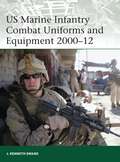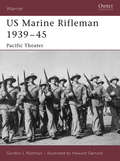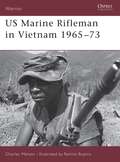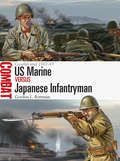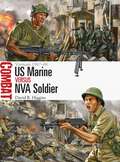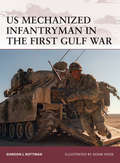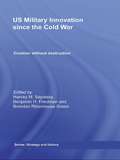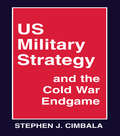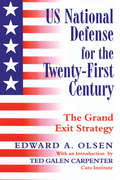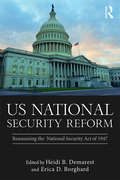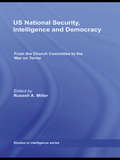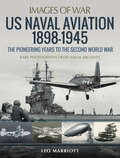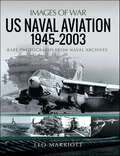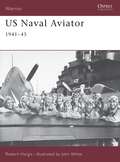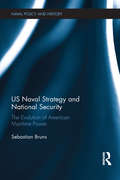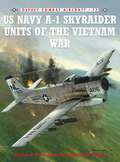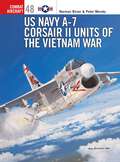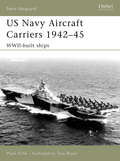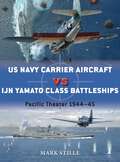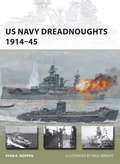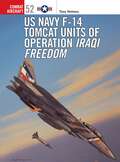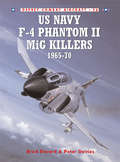- Table View
- List View
US Marine Infantry Combat Uniforms and Equipment 2000-12
by Kenneth Ewald J. EwardThe US Marine Corps has been a key part of the US presence in a host of combat zones in the first years of the 21st century, from Iraq to Afghanistan. With a front-line strength of over 200,000 active-duty personnel, the USMC is significantly larger than the entire armed forces of some countries. It fulfils a vital component of the United States' military capability, uniquely being able to deploy a combined-arms task force to almost anywhere across the globe in a matter of days. The infantry role is at the heart of USMC thinking; all Marines are trained as riflemen, and other components of the USMC, such as Marine aviation, have always been tasked first and foremost with supporting the infantry on the ground.While sharing some weapons systems with the US Army, US Navy, and US Air Force, the Marine Corps has developed its own distinctive approach to matters of dress, personal equipment and armament. Since the year 2000 the "profile" of the Western combat infantryman has changed greatly. The most important trends are a new generation of camouflage clothing, body armor, personal electronics, and night-vision equipment, which have transformed the appearance and capability of the individual rifleman. Another trend is the increased presence of women on the battlefield, which has design implications. The men and women of the USMC have been at the forefront of these developments, utilizing innovative items of dress and equipment during their extensive service in a range of challenging environments across the world.Featuring specially commissioned full-color artwork and detailed photographs, this book explores the USMC's key contribution to the development of the combat infantry soldier's clothing and personal equipment in the 21st century.
US Marine Rifleman 1939-45
by Howard Gerrard Gordon RottmanOsprey's study of United States Marine Corps riflemen during World War II (1939-1945). It is sometimes a basic assumption that a US Marine Corps rifleman was essentially trained, uniformed, equipped, and armed much the same as a US Army rifleman during World War II. While there were of course similarities, the Marines conducted their own unique training programs, wore mostly different uniforms and equipment, and possessed some unique weapons, although they also used many of the same weapons as the Army. The Marine Corps was not part of the Navy, but a component of the Navy Department alongside the Navy. While the Marines specialized in amphibious warfare, the Army actually conducted more amphibious assaults in the Pacific than the Marines. The typical Marine was extremely proud of his service and acutely aware that there were only six Marine divisions but 89 Army divisions. The Marine Corps began World War II with less than 66,000 officers and men; more than that would be wounded before it ended. The Corps grew to almost 487,000. It provided only 5 percent of the US armed forces, but suffered 10 percent of overall American casualties.The Marines were able to build on their proud traditions and history to transform a small branch of service into a premier combined arms amphibious assault force. Regardless of its expansion by 750 percent, the Corps was able to maintain its sense of tradition, instill that into thousands of new Marines, and create an elite arm of service. Here, Gordon L Rottman, follows the Marine rifleman through his draft and training, and then participation in operations such as Roi-Namur in the Marshall Islands, Saipan and Tinian in the Mariana Islands, and Iwo Jima.The opening sentences of the Marine Creed, composed shortly after the attack on Pearl HarborThis is my rifle. There are many like it, but this one is mine. It is my life. I must master it as I must master my life. Without me my rifle is useless. Without my rifle, I am useless.
US Marine Rifleman in Vietnam 1965-73
by Ramiro Bujeiro Charles MelsonThis volume provides an in-depth look at the experience of the ordinary US marine 'grunt' in Vietnam. Organisation of the corps, weaponry, equipment, uniforms, training and medical arrangements are all discussed. However, where this book differs from other similar works is not only in the detail that it goes into but also in the unifying theme of examining all these differing aspects of marine life from the point of view of a soldier serving in the conflict. The author, Charles Melson, actually served in the Vietnam War (1955-1975), and it is this personal experience that allows him to provide such a unique angle on the subject.
US Marine vs Japanese Infantryman: Guadalcanal 1942-43
by Gordon Rottman Johnny ShumateThe bitter six-month struggle for control of Guadalcanal in the South Pacific during World War II matched the US Marine Corps against the Imperial Japanese Army in a campaign that would test both sides to the limit. In this book the realities of prolonged warfare in an unforgiving environment are documented in photographs, specially commissioned artwork, official reports, and first-hand accounts, offering a glimpse of infantry combat in World War II's Pacific Theater.The toughness of American Marines was sorely tested by Japanese troops willing to lay down their lives in Banzai charges and desperate last stands across the Pacific in World War II. This book offers key insights into the tactics, leadership, combat performance, and subsequent reputations of six representative USMC and IJA infantry battalions pitched into three pivotal actions that determined the course of the campaign for Guadalcanal at the height of World War II.Mountainous and covered in tropical jungle, Guadalcanal is the largest of the Solomon Islands. During World War II its location - dominating vital lines of communication and supply between the United States, Australia, and New Zealand - made it a key strategic objective for both sides in the escalating struggle for the South Pacific region. Between August 7, 1942 and February 9, 1943 it was the setting for a series of bitter battles between the advancing Japanese forces and those of a resurgent United States and its allies, in the Allies' first major offensive against the Japanese.Spearheading the Allied effort to take and hold Guadalcanal, the US Marine Corps played a key role in the back-and-forth land battles for this vital island, while their adversaries, the garrison troops of the Imperial Japanese Army, strove to counter the Allies' offensive moves. From the initial US landings that took the Japanese by surprise to the savage battles of Tenaru, Edson's Ridge, Henderson Field, and Mount Austen, the campaign tested the infantrymen of both sides to the limit, with tropical diseases, supply problems, hostile terrain, and poor weather all adding to the horrors of close-quarter combat.
US Marine vs NVA Soldier: Vietnam 1967-68
by Johnny Shumate David HigginsIn 1967-68, the United States Marine Corps (USMC) was on the front line of the defense of South Vietnam's Quang Tri province, which was at the very heart of the Vietnam conflict. Facing them were the soldiers of the North Vietnamese Army (NVA), men whose organization and equipment made them a very different opponent from the famous, irregular Viet Cong forces. From the "Hill Battles" in April 1967 to the struggle for the city of Huế (January-March 1968) this bloody campaign forced the two sides into a grueling trial of strength. The USMC held a general technological and logistical advantage - including close air support and airborne transport, technology, and supplies - but could not always utilize these resources effectively in mountainous, jungle, or urban environments better known by their Vietnamese opponents. In this arresting account of small-unit combat, David R. Higgins steps into the tropical terrain of Vietnam to assess the performance and experience of six USMC and NVA units in three savage battles that stretched both sides to the limit.
US Marines Alphabet Book
by Jerry Pallotta Sammie GarnettTake a look at fascinating facts about the US Marines--one for each letter of the alphabet! There's a lot to learn about this important branch of our armed forces.With information from both history and the modern era, each letter covers something related to the Marines. From fire teams to jets, and from Parris Island to uniforms, this book is a wealth of information that highlights the courage and commitment it takes to serve in the US Marines.
US Mechanized Infantryman in the First Gulf War
by Adam Hook Gordon RottmanOsprey's examination of the US Mechanized Infantrymen of the First Gulf War (1990-1991), In many ways the end of the Vietnam War left the US army a spent force. Plagued by low morale, drug and race issues, and terrible public relations, the army faced an uphill climb in the effort to rebuild itself. The story of this reconstruction is mirrored in the rise of the Mechanized Infantryman. Deciding that the key to future conflict lay in highly trained and mobile warriors that could be delivered quickly to battle, the army adopted the mechanized infantryman as its frontline troops. This new, all-volunteer force was given the best training and equipment that money could buy. Most notably, they were to be deployed onto the battlefield from the new M2 Bradley Armored Fighting Vehicle.This new breed of American warriors got their first test in the First Gulf War. Fighting in the deserts of Kuwait and Iraq, these soldiers proved that the US Army was once again a force with which to be reckoned. This book tells the complete story of the rise of the US mechanized infantryman, focusing on his recruitment, training, lifestyle and combat experiences in Iraq.From the Trade Paperback edition.
US Military Innovation since the Cold War: Creation Without Destruction (Strategy and History)
by Harvey Sapolsky Benjamin Friedman Brendan GreenThis book explains how the US military reacted to the 'Revolution in Military Affairs' (RMA), and failed to innovate its organization or doctrine to match the technological breakthroughs it brought about. Many called for the transformation of the US military in the years after the end of the Cold War, seeking the changes in organization and doctrine that would complete the RMA innovation and a commitment to counter-insurgency, peace keeping and nation building missions. This volume describes the origins, uses, and limits of the RMA technologies, examines how each of the five US armed services (categorising the Special Operations as a separate service) made their adjustments both to the technologies and the use of force, and how the role of the civilian officials and the defense industry altered in this process of change and avoidance of change. The book examines the internal politics of the services as well as civil/military relations to identify the external pressures on the services for significant change in their doctrine and weapons. Many have noted the failure of the services to innovate in what can be called the 'Second Inter-war Period' (the years after the Cold War). This book offers explanations for this failure and arguments about the possible range and desirability of military innovation in the post-Cold war era. This book will be of great interest to students of strategic studies, US defence politics, military studies, and US politics. Harvey M. Sapolsky is Professor of Public Policy and Organization in the Department of Political Science at MIT and former Director of the Security Studies Program. Benjamin H. Friedman is a Research Fellow in Defense and Homeland Security Studies at the Cato Institute and a Ph.D. Candidate in Political Science at MIT. Brendan Green is a Ph.D. Candidate in Political Science at MIT and an affiliate of the Security Studies Program.
US Military Strategy and the Cold War Endgame
by Stephen J. CimbalaAt the end of the Cold War security concerns are more about regional and civil conflicts than nuclear or Eurasian global wars. Stephen Cimbala argues that deterrence characteristics of the pre-Cold War period will in the 21st century again become normative.
US National Defense for the Twenty-first Century: Grand Exit Strategy
by Edward A. OlsenThis provocative critique of Washington's current security policies, draws on the arguments made by an array of non-interventionist and conservative-nationalist scholars. It provides a blueprint for a more restrained and unilateral US role in global affairs.
US National Security Concerns in Latin America and the Caribbean
by Harry E. Vanden Gary Prevost Carlos Oliva Campos Luis Fernando AyerbeThe concepts of 'ungoverned spaces' and 'failed states' where the limited presence of the state is seen as a challenge to global security have generated a rich intellectual debate in recent years. In this edited volume, scholars from Latin America and the United States will analyze how US foreign policy making circles have applied the concepts to the creation of new US security initiatives in the Latin American region during the post September 11, 2001 era. The extension of concepts to Latin America has been significant because it has meant that during the past thirteen years US policy in the Hemisphere has shifted away from the primarily economic emphasis of the 1990s, the era of the Free Trade Area of the Americas project, back to a security focus reminiscent of the Cold War era. The last decade has witnessed a significant increase in US military presence in the region highlighted by the re-launching of the Caribbean-based Fourth Fleet, the militarization of drug fighting efforts in Mexico, and the establishment of several new military bases in Colombia, the staunchest US ally in the region.
US National Security Reform: Reassessing the National Security Act of 1947 (Routledge Global Security Studies)
by Heidi B. Demarest Erica D. BorghardThis collection of essays considers the evolution of American institutions and processes for forming and implementing US national security policy, and offers diverse policy prescriptions for reform to confront an evolving and uncertain security environment. Twelve renowned scholars and practitioners of US national security policy take up the question of whether the national security institutions we have are the ones we need to confront an uncertain future. Topics include a characterization of future threats to national security, organizational structure and leadership of national security bureaucracies, the role of the US Congress in national security policy making and oversight, and the importance of strategic planning within the national security enterprise. The book concludes with concrete recommendations for policy makers, most of which can be accomplished under the existing and enduring National Security Act. This book will be of much interest to students of US national security, US foreign policy, Cold War studies, public policy and Internationl Relations in general.
US National Security, Intelligence and Democracy: From the Church Committee to the War on Terror (Studies In Intelligence Ser.)
by Russell MillerThis volume examines the investigation by the 1975 Senate Select Committee ( Church Committee ) into US intelligence abuses during the Cold War, and considers its lessons for the currentwar on terror. This report remains the most thorough public record of America‘s intelligence services, and many of the legal boundaries operating on US intelligence.
US National Security: Policymakers, Processes, and Politics
by Stephen J. Cimbala Sam C. Sarkesian John Allen WilliamsThe main focus of US national security policy has shifted dramatically since the years of the Obama administration, moving away from nation building and counterinsurgency efforts and toward preparing for traditional state-on-state conflict with powerful peers. The sixth edition of US National Security reflects that change. It also addresses such current issues as the impact of an increasingly partisan political process, sharp divisions in public opinion, the ongoing challenges of homeland security, and developments in cyberspace and other possible domains of future warfare. <P><P>Retaining the successful structure and approach of the previous editions, the book clearly introduces and explores the full range of actors, processes, and politics involved in maintaining US national security.
US Naval Aviation, 1898–1945: The Pioneering Years to the Second World War (Images of War)
by Leo MarriottThis pictorial history tells the story of US naval aviation from its early beginnings in the 1920s to its dominance in the Pacific theater of WWII.The Japanese attack on Pearl Harbor sank or crippled almost all of the battleships in the US Navy’s Pacific Fleet. But the fleet’s aircraft carriers survived—and soon demonstrated the power of US naval aviation. Thanks to pioneering technology and far-sighted pre-war policy, the US Navy had the necessary ships, aircraft, and crews to turn the tide of the Pacific war.With more than 200 rare photographs, Leo Marriott traces the growth of US naval aviation from the flimsy seaplanes of the first years of the twentieth century to the mighty armadas that challenged those of the Japanese and, after the carrier battles at Coral Sea and Midway, led the advance across the Pacific. Marriott puts special focus on the navy’s first aircraft carriers of the 1920s, the tremendous progress made in the decades between the wars in tactics and strategy, and the innovative design of ships and aircraft themselves.
US Naval Aviation, 1945–2003 (Images of War)
by Leo MarriottIn this the highly illustrated second volume of his history of US naval aviation, Leo Marriott takes the reader through the extraordinary developments in design and capability that transformed American aircraft and aircraft carriers after the Second World War, and he describes the succession of conflicts in which they were deployed. Increasingly, advanced jets replaced propeller-driven aircraft and nuclearpowered carriers allowed the US Navy to project American military power across the world. As the many remarkable photographs in this book show, wherever naval aviation was involved, it played a crucial role, especially in the wars in Korea and Vietnam. The vessels built in the 1940s to fight in the war against Japan gave way to a new generation of super carriers. Supersonic fighters and strike aircraft entered service – the F-8 Crusaders and F-4 Phantoms of the Vietnam era, then the F-14 Tomcat, F/A-18 Hornet and S-3 Viking of more recent times. Carrier-based helicopters became more important, first for search-and-rescue missions, then for anti-submarine warfare and for landing assault forces. Throughout this period of the Cold War the US Navy’s carriers and aviation served to demonstrate American power worldwide and to counter the threat represented by the Soviet Union’s challenge to US mastery of the seas.
US Naval Aviator
by John White Robert HargisThe US naval aviator of World War II played a pivotal part in the winning of the war. From the warm waters of the Pacific to the icy conditions of the Bering Sea (including the battle of Midway), the Naval aviator was on hand to fight the enemy in any and all conditions. Between 1940 and 1942 the training of the naval aviator lasted eleven months, divided into five separate and distinct phases. From phase one, known as the Elimination or "E" base for short, through to final assignment to a carrier based squadron, the training was demanding and unrelenting.This title examines the life and experiences of the US Naval Aviator in all three types of carrier squadron - fighters (VF), dive-bombers (VB) and the torpedo squadrons (VT). From recruitment to battle, the detail of what it was like to fly and fight for the US Navy is brought vividly to life.
US Naval Strategy and National Security: The Evolution of American Maritime Power (Cass Series: Naval Policy and History)
by Sebastian BrunsThis book examines US naval strategy and the role of American seapower over three decades, from the late 20th century to the early 21st century. This study uses the concept of seapower as a framework to explain the military and political application of sea power and naval force for the United States of America. It addresses the context in which strategy, and in particular US naval strategy and naval power, evolves and how US naval strategy was developed and framed in the international and national security contexts. It explains what drove and what constrained US naval strategy and examines selected instances where American sea power was directed in support of US defense and security policy ends – and whether that could be tied to what a given strategy proposed. The work utilizes naval capstone documents in the framework of broader maritime conceptual and geopolitical thinking, and discusses whether these documents had lasting influences in the strategic mind-set, the force structure, and other areas of American sea power. Overall, this work provides a deeper understanding of the crafting of US naval strategy since the final decade of the Cold War, its contextual and structural framework setting, and its application. To that end, the work bridges the gap between the thinking of American naval officers and planners on the one hand and academic analyses of Navy strategy on the other hand. It also presents the trends in the use of naval force for foreign policy objectives and into strategy-making in the American policy context. This book will be of much interest to students of naval power, maritime strategy, US national security and international relations in general.
US Navy A-1 Skyraider Units of the Vietnam War
by Jim Laurier Rick Burgess Zip RausaOsprey's examination of the A-1 Skyraider Units' participation in the Vietnam War (1955-1975). Designed and built as a carrier-based attack aircraft in 1944, the A-1 reached frontline units too late to see combat in World War II (1939-1945). With the advent of jets in the late 1940s, the Skyraider was seen as a dated throwback to the golden age of piston-engined naval aviation. Despite its days seemingly numbered, the A-1 proved to be a huge success in the Korean War. Remaining in production through to 1957, some 3,180 Skyraiders had been built by the time the last one left the Douglas plant. Nicknamed the ''flying dump truck'', the A-1 remained a key component in naval air wings into the 1960s, allowing the aircraft to play its part in the escalating conflict in Vietnam. Both A-1 attack and EA-1F airborne early warning aircraft saw action in Southeast Asia from 1960 through to 1969, when the last examples were finally retired from carrier decks. The A-1s in particular bombed targets in both North and South Vietnam, despite the aircraft being highly vulnerable to enemy flak and fighters. Co-written by a two-tour Vietnam War combat veteran in the A-1, this is the first book that focuses exclusively on the aircraft's service in Vietnam, providing a must-have volume for Vietnam aviation enthusiasts.
US Navy A-7 Corsair II Units of the Vietnam War
by Peter MerskyOsprey's examination of A-7 Corsair II Units of the Vietnam War (1955-1975). Arriving on station with the USS Ranger (CVA-61) in early December 1967, the first Corsair II squadron became operational immediatedly and sustained its first combat loss three weeks later. This book tells how the A-7 soon proved its worth supporting ground operations in South Vietnam. As it continued to serve in the ground support role, the navy swiftly introduced the A-7E which soon ran into difficulties with supply lines - perhaps on account of what many perceived to have been a rushed introduction to service. Once these teething problems were resolved, the A-7E became the primary air-to-ground aircraft of the fleet.
US Navy Aircraft Carriers 1942-45
by Tony Bryan Mark StilleDominating the seas during World War II, the US aircraft carrier played a crucial role in every major naval combat of the war. Development of the Essex class began in 1941, and was the largest class of carrier ever built. During the Pacific War it formed the backbone of any fighting force and became renowned for its mighty 'Sunday Punch' - the impressive offensive power of 36 fighter planes, 36 dive bombers, and 18 torpedo planes.The Independence class was a lighter and faster carrier, built after Pearl Harbor, to bring more ships into action as quickly as possible. Alongside the Essex class their crews saw a dramatic change in tactical deployment as they began to form the fast carrier task forces that were so effective in Pacific operations.Featuring an annotated cutaway and artwork detailing both the interior and exterior features of the ships, this book explores the design, development, and deployment of both the Essex and Independence class of light carriers. This sequel to US Navy Aircraft Carriers 1922-45: Prewar classes (New Vanguard 114), provides a detailed exploration of the carriers that were at the forefront of many actions in World War II, including the climatic battles of Phillipine Sea and Leyte Gulf in 1944.
US Navy Carrier Aircraft vs IJN Yamato Class Battleships
by Jim Laurier Mark StilleAs the Pacific War approached a crescendo, the clashes between swarming US Navy carrier aircraft, and the gigantic Imperial Japanese Navy (IJN) Yamato-class battleships became symbolic of the fortunes of the two nations. They also served as a metaphor for the profound changes in naval technology and doctrine that the war had brought about. The two opposing forces were the most powerful of their kind - the Japanese Yamato and Musashi were the biggest most heavily armored and armed battleships ever built, while US carrier aviation had evolved into a well-oiled, war-winning machine. With detailed analysis of the technical features of the opposing war machines and a gripping account of the fighting itself, this vividly illustrated work presents views from the cockpits of US Navy Divebombers, and down the sights of IJN anti-aircraft guns, during two of the most dramatic naval engagements ever fought. After proving at Pearl Harbor that even the mightiest battleships were vulnerable to air attack, the Japanese would be forced to re-learn the lesson as the American Helldiver and Avenger bomber crews battered and eventually sunk the last remaining jewels of the Imperial Japanese Navy. Never again would a surface fleet be the dominant power at sea.
US Navy Dreadnoughts 1914-45
by Paul Wright Ryan NoppenWhen the United States went to war with Spain in April 1898, few European observers believed the small and relatively inexperienced American navy could achieve a decisive naval victory over an established European colonial power. In less than five months however, two Spanish naval squadrons lay at the bottom of the seas and the once great Spanish Empire ceded its last colonies in Asia and the New World to the upstart Americans. Admiral George Dewey, victor at the battle of Manila Bay, became a demigod in the eyes of the American media and public overnight and the excitement of new conquests overseas breathed new life into the traditional American expansionist doctrine of Manifest Destiny. The American naval hubris that developed in the wake of the Spanish-American War in reality rested on only a handful of modern battleships in a navy that was an obsolescent coastal defense force only ten years before. No one understood this better than Theodore Roosevelt. An expansionist who fought with distinction during the war with Spain and an advocate of the sea power theories of Captain Alfred Thayer Mahan, Roosevelt knew the present American navy was not strong enough to defend American shores against the larger navies of Europe let alone those of a new empire. European powers still skirted the Monroe Doctrine as evidenced by the British-German-Italian blockade of Venezuela from 1902-03 and the Dutch FI Venezuela War of 1908, and the United States was increasingly threatened in the Philippines, Samoa, and the Caroline and Marshall Islands by the imperial ambitions of Germany and Japan. To remedy the lack of naval preparedness for America's sudden emergence as a world power, Roosevelt and the United States embarked on rapid naval building program. To emphasize America's growing naval prowess and to demonstrate his "speak softly and carry a big stick" approach to foreign policy, Roosevelt sent the Great White Fleet, a squadron composed of sixteen battleships (all commissioned after 1898), to circumnavigate the globe, a great technical and logistical feat for the time. As impressive as the spectacle of the Great White Fleet was, all of the ships in it were quickly being rendered obsolescent by the dreadnought-type battleships coming into service in Great Britain and Germany. This did not catch the United States off-guard however for as the Great White Fleet was completing its world cruise, the USS South Carolina, America's first dreadnought whose design pre-dated that of HMS Dreadnought, was already fitting out. By the beginning of World War I, the United States possessed the third largest navy in the world and had ten dreadnoughts in service with four more under construction.
US Navy F-14 Tomcat Units of Operation Iraqi Freedom
by Jim Laurier Tony HolmesSince the limited Desert Fox campaign against Iraq in December 1998, the Tomcat has been integral to virtually all combat operations involving the US Navy in the Arabian Gulf. Indeed, on every carrier deployment to the Persian Gulf since Desert Fox, the F-14 unit(s) on station has ventured into 'The Sand Box' over southern Iraq and prosecuted targets operating in contravention to United Nations security council resolutions. This book covers the F-14 Operation Iraqi Freedom (2003-present) actions against battlefield targets and integrated air defence sites, command and control centres, regime leadership targets and military installations in Baghdad, Tikrit, Mosul and Kirkuk.
US Navy F-4 Phantom II MiG Killers 1965-70
by Jim Laurier Brad ElwardFor every American fighter pilot involved in the Vietnam War (1955-1975), the ultimate goal was to 'kill a MiG'. In eight years of conflict 43 Vietnamese Peoples Air Force aircraft were claimed by US Navy and US Marine Corps Phantom II crews, and one single ace crew produced. Navy Phantom IIs scored the first kills of the Vietnam War, in April 1965, as well as scoring the last in January 1973. This volume charts the successes of the navy fighter crews as they encountered 'MiGs, Missiles and AAA' over the jungles of North Vietnam.
